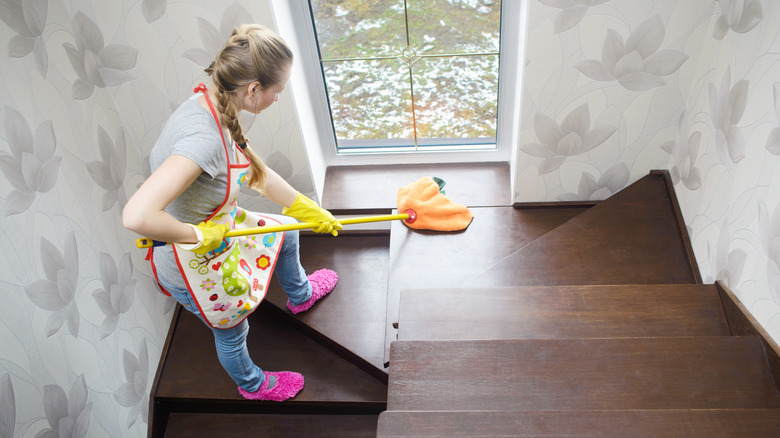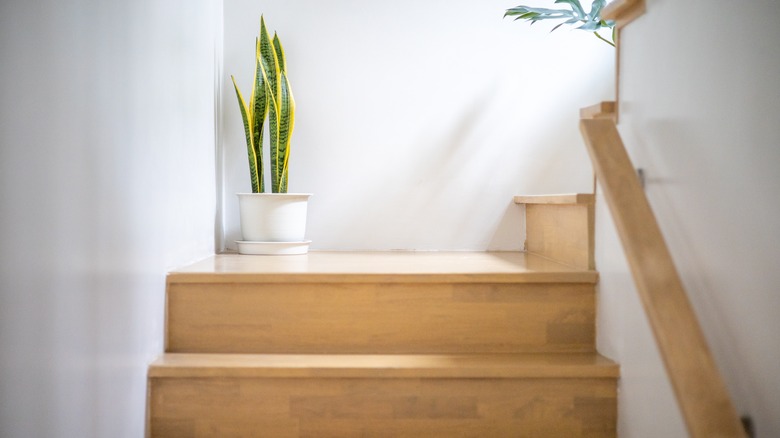The Old-School Product That Will Keep The Corners Of Your Stairs Dust-Free
There's nothing like dust to dampen one's desire to maintain an immaculate home. This silent intruder can make every corner of the house its personal space. And no matter how diligently we clean, it always seems to find its way back into our living spaces, settling into every nook and cranny. Staircases, in particular, present a unique challenge. As traffic arteries between floors, they endure constant footfall, which, in turn, stirs up dust from the carpet or wood treads. This dust then accumulates in the corners, defying our efforts to keep our homes clean and dust-free. Yet a simple yet ingenious solution exists to this age-old problem: stair dust corners, also known as stair edge guards, dust guards, or stair nosings.
Believe it or not, stair dust corners have been around since the 19th century, made to simplify sweeping tasks. Yes, these unassuming yet highly effective devices are products of the Victorian era, and you can use them in your own home. Stair dust corners typically have a triangular or wedge-shaped profile that fits snugly into the corners of staircases. They are designed to cover the intersection where the riser (vertical part) meets the tread (horizontal part) of each step.
Practical and aesthetic functions of stair dust corners
Stair dust corners serve a dual purpose –- they not only offer a practical function in maintaining cleanliness but also enhance the aesthetics of your staircase. They primarily function as barriers against dust piling up in the corners of the stairs. They are ingeniously designed with an angled overlap and a snug fit, precisely engineered to capture debris like dirt, dust, pet hair you yearn to get rid of, and crumbs that fall on the stairs. By preventing clumps of dust from gathering in the hard-to-reach corners of each step, cleaning becomes a bit easier.
If your house has a design or theme, stair dust corners can be customized to complement the look and feel of your home. You can use them to add a touch of vintage charm to your staircase. Originally, stair dust corners were crafted from wood or metal like brass or nickel by skilled artisans. Today, they're available in various materials (e.g., rubber and vinyl), finishes, and patinas, blending seamlessly with your home décor, adding a finishing touch and giving your staircase a polished appearance.
To install them, wedge each stair dust corner into place and secure it with a long nail. Make sure there's enough overlap so you have a larger surface area to catch dust and debris. During installation, check the snugness of the fit, as a tight seam is essential to prevent dust from slipping through any gaps.
Stair dust corner care and maintenance
While stair dust corners undoubtedly reduce dust accumulation on stairs compared to exposed edges, their dust-catching capabilities are valuable but not limitless. You still need to maintain them to maximize their effectiveness. Periodically clean your stair dust corners along with the rest of your staircase to prevent dust from accumulating. Choose cleaning tools and products that are gentle yet effective to avoid damaging the corners.
In case you want to give stair dust corners a try or think they fit your home aesthetic perfectly, you can find them at Vintage Hardware and Lighting in various finishes (polished brass, antique brass finish, and oil-rubbed bronze finish), where they retail for $12.50 each. You can also get them online at House of Antique Hardware at prices ranging from $3.29 to $10.19 each, depending on the design and finish. They're also available at Van Dyke's Restorers, handmade ones particularly, priced at $59.99 for a pack of 12.
If you have other tricky spots in your home that are challenging to clean, consider using these stair dust corner guards. Placing them in the corners around your fireplace molding or beneath your kitchen cabinets, for example, can make cleaning those spots easier. Keep in mind that however helpful stair dust corners may be, they aren't made to replace the need for regular vacuuming and wiping.


